Cigar Tip: Make the Heart Grow Fonder
27 Aug 2012
Last night I lit up my first cigar in seven days, and I would wager it was at least twice as enjoyable as it would have been had it been my fourth or fifth cigar of the week.
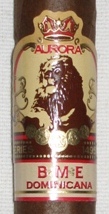 To get back in the swing of things, I fired up a nice 1495 B.M.E. Dominicana on a stormy night here in Chicago. It was everything I was hoping for and more. Cedar, spice, graham cracker, cream…all with a smooth delivery and near perfect construction. I savored every puff of that La Aurora and enjoyed the heck out of it—probably in no small part due to the fact that I had been on a cigar hiatus.
To get back in the swing of things, I fired up a nice 1495 B.M.E. Dominicana on a stormy night here in Chicago. It was everything I was hoping for and more. Cedar, spice, graham cracker, cream…all with a smooth delivery and near perfect construction. I savored every puff of that La Aurora and enjoyed the heck out of it—probably in no small part due to the fact that I had been on a cigar hiatus.
The hiatus was not self-imposed. Last Monday I woke up with a head cold and battled it all week. In typical fashion, it started with a scratchy throat that turned into a sore throat, then my nose got all stuffed up, and then I just started to feel achy and tired. I’ve read that the average adult experiences two to four colds per year, so I guess I was due.
As I’ve written before, I try not to smoke cigars while I have a cold. Not, mind you, because I think cigars may prolong the cold (although doctors say smokers tend to have longer colds—but then again, doctors say a lot of things). No, I choose to abstain from cigars while sick because, quite simply, I can’t really taste cigars when I’ve got clogged sinuses. My nose is the best instrument I have for tasting cigars, which is why I smoke through the nose when I’m trying to get a complete sense of its profile.
Of course, the timing of the cold wasn’t very good (is it ever?). The same day I started to feel sick was the day my smoke kit from the 2012 Saints & Sinners club arrived in the mail. Last year was the debut of the Tatuaje club, which entitles members to exclusive smokes and members-only forums. This year, the kit included 15 handsome cigars from Pete Johnson, including nice extras like a hat, poker chips, and a lighter. Anyways, the point is it didn’t feel good to have beginnings of a cold right as a nice package of Tatuajes arrives—even if it probably makes sense to let the cigars rest after shipment.
Now that I’m back in the game, though, I’m kind of glad I refrained from cigar smoking for a little while. The brief vacation from cigars reminded me just how lucky I am to have cigars in my life. And that first one I lit up was an absolute treat. So if you’re ailing from a head cold—or if you’re a three-cigar-a-day smoker who’s in a rut—you might try giving cigars a rest for a bit. When you come back, it will be all the sweeter.
photo credit: Stogie Guys

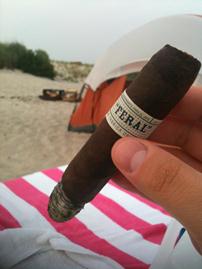 Now I’m not typically what you’d call “outdoorsy.†The camping part of the trip was my wife’s idea. I decided to comply with her request because (1) she always gets her way in the end anyhow and (2) it was high time we got some use out of all the camping gear we received as wedding gifts two years ago. So for three nights we camped in the sand a few hundred feet from the Atlantic Ocean. By and large, it was a lot of fun. It was also a lot of work.
Now I’m not typically what you’d call “outdoorsy.†The camping part of the trip was my wife’s idea. I decided to comply with her request because (1) she always gets her way in the end anyhow and (2) it was high time we got some use out of all the camping gear we received as wedding gifts two years ago. So for three nights we camped in the sand a few hundred feet from the Atlantic Ocean. By and large, it was a lot of fun. It was also a lot of work.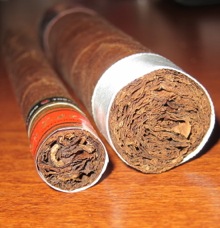 The size of a cigar affects many things for sure, and not just the time it takes a cigar to burn. There are two main reasons why, as a general rule of thumb, smaller sized cigars (of the same blend) are more flavorful than their larger counterparts, even though many people seem to believe that a larger cigar will produce more and stronger flavors.
The size of a cigar affects many things for sure, and not just the time it takes a cigar to burn. There are two main reasons why, as a general rule of thumb, smaller sized cigars (of the same blend) are more flavorful than their larger counterparts, even though many people seem to believe that a larger cigar will produce more and stronger flavors.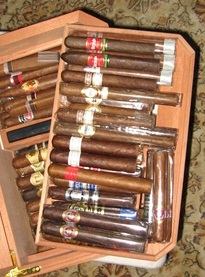 Sometimes I think those of us who regularly visit the online cigar community, or those of us who write for it, automatically assume every reader has one elaborate cigar storage setup that costs thousands of dollars. I’m sure some do. But I don’t. And chances are you don’t, either. That said, I want to be clear that I’m not complaining. As I’ve written before, I’m fortunate to have a wonderful
Sometimes I think those of us who regularly visit the online cigar community, or those of us who write for it, automatically assume every reader has one elaborate cigar storage setup that costs thousands of dollars. I’m sure some do. But I don’t. And chances are you don’t, either. That said, I want to be clear that I’m not complaining. As I’ve written before, I’m fortunate to have a wonderful  No matter what your opinion of U.S. foreign policy, one thing that shouldn’t be divisive is supporting our troops. And you needn’t wait for a holiday to do your part. Year round, men and women who are serving in dangerous conditions would appreciate any spare cigars you can send their way.
No matter what your opinion of U.S. foreign policy, one thing that shouldn’t be divisive is supporting our troops. And you needn’t wait for a holiday to do your part. Year round, men and women who are serving in dangerous conditions would appreciate any spare cigars you can send their way.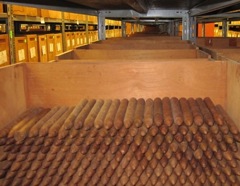 Tobacco is organic matter, which means that chemically it will change with time. During a cigar’s life, the tobacco changes, and that impacts the flavor. Today I’m breaking down aging into three basic categories:
Tobacco is organic matter, which means that chemically it will change with time. During a cigar’s life, the tobacco changes, and that impacts the flavor. Today I’m breaking down aging into three basic categories: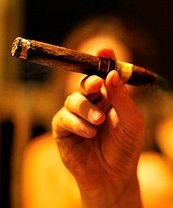 I’m starting a campaign to share venues that are cigar-cordial and likely not on the typical list of such places. Hopefully it can be a resource for everyone, from those traveling to an unfamiliar location to folks seeking a new experience right around home. I’ll kick it off with two places in my general area (Tampa Bay) where I’ve enjoyed cigars in a friendly atmosphere.
I’m starting a campaign to share venues that are cigar-cordial and likely not on the typical list of such places. Hopefully it can be a resource for everyone, from those traveling to an unfamiliar location to folks seeking a new experience right around home. I’ll kick it off with two places in my general area (Tampa Bay) where I’ve enjoyed cigars in a friendly atmosphere. Patrick Ashby
Co-Founder & Editor in Chief
Patrick Ashby
Co-Founder & Editor in Chief Patrick Semmens
Co-Founder & Publisher
Patrick Semmens
Co-Founder & Publisher George Edmonson
Tampa Bureau Chief
George Edmonson
Tampa Bureau Chief